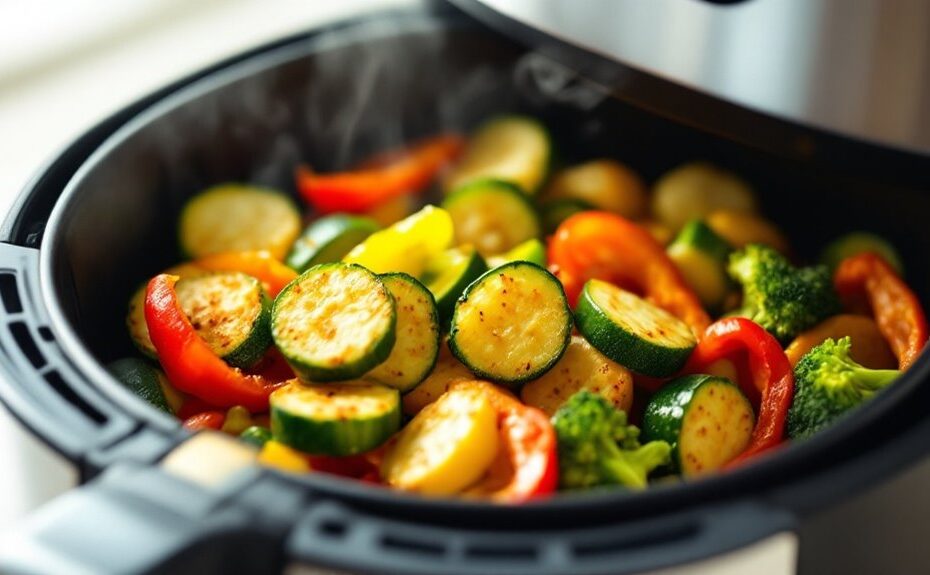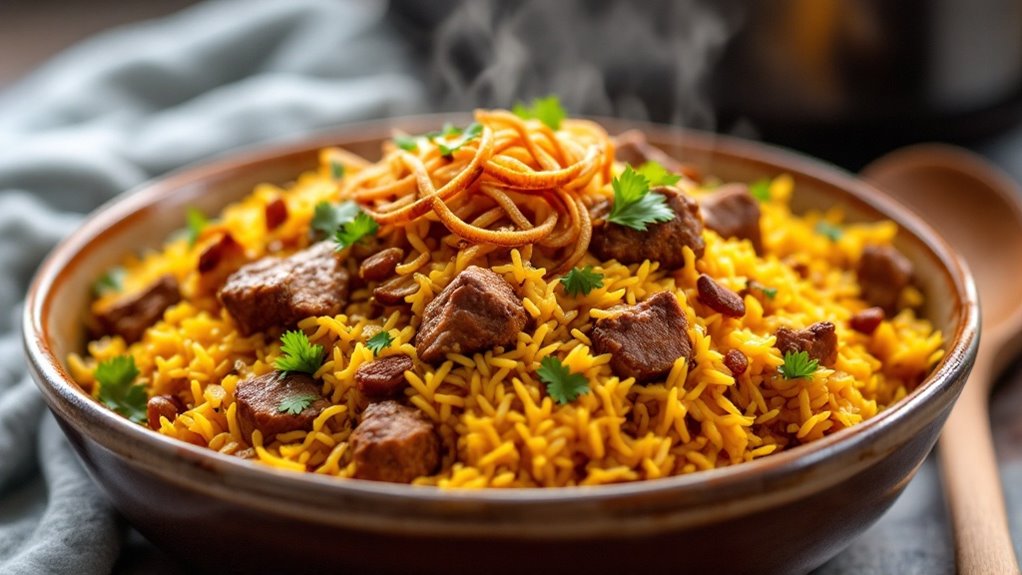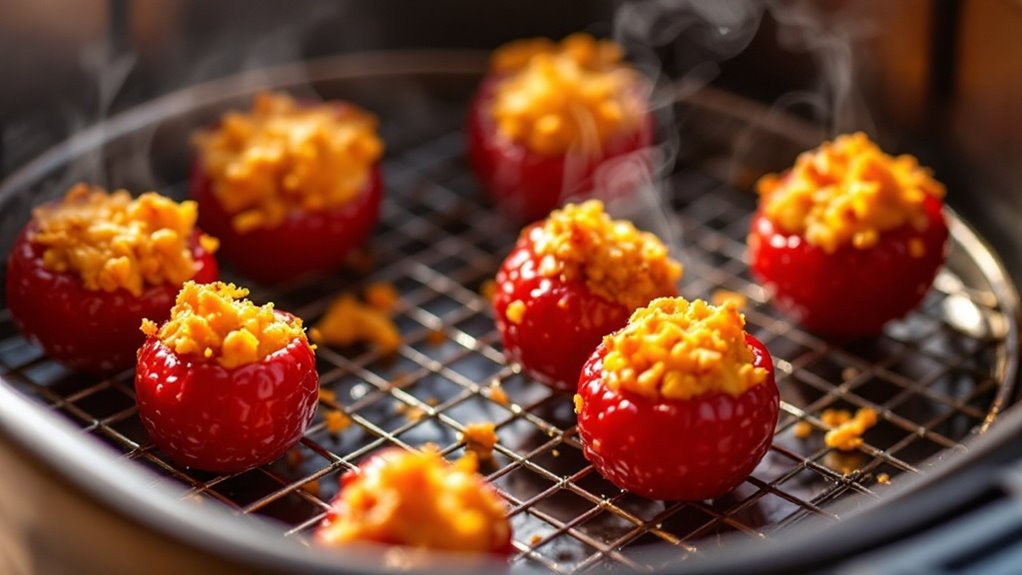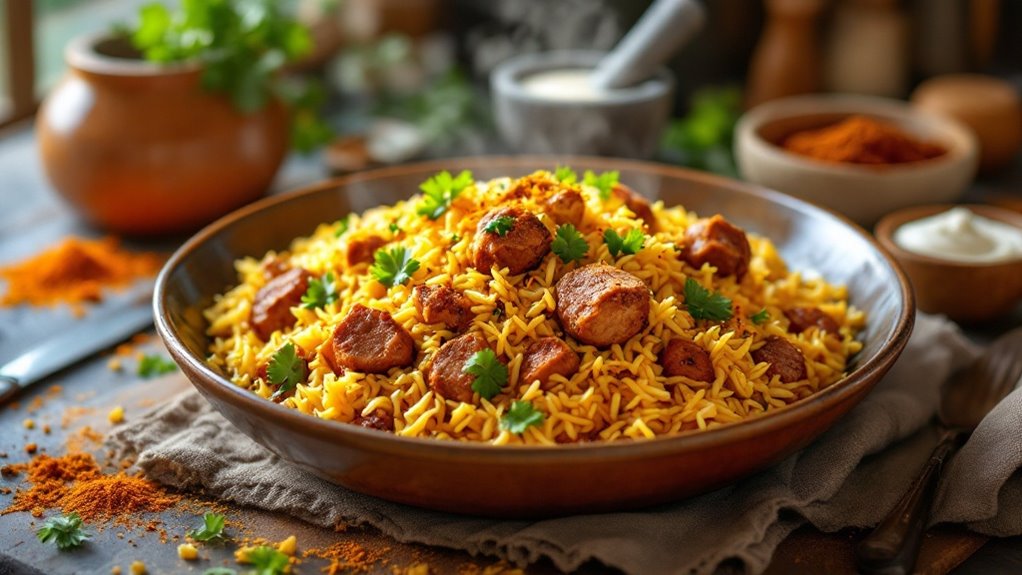Imagine your air fryer as a magician, transforming soggy fries into golden perfection without a drop of oil. You might wonder if this kitchen gadget can truly deliver crispy, flavorful results without relying on fat. The answer lies in its ability to circulate hot air, creating a texture that rivals traditional frying. But how do you achieve the best results, and what foods shine brightest without oil? The secrets to mastering oil-free cooking are simpler than you think, yet they hold the key to healthier, guilt-free meals. What you don't know might just change the way you approach your next dish.
Key Takeaways
- Air fryers use rapid hot air circulation to crisp food without oil, mimicking deep-frying effects.
- Nonstick liners and perforated parchment paper prevent sticking while maintaining proper airflow for even cooking.
- Oil-free cooking reduces calorie intake, retains nutrients, and minimizes harmful compounds like acrylamide.
- Foods like vegetables, lean proteins, and tofu crisp up well in an air fryer without added oil.
- Preheat the air fryer, pat food dry, and avoid overcrowding for crispy, oil-free results.
How Air Fryers Work Without Oil
Air fryers cook without oil by circulating hot air rapidly around the food, creating a crispy exterior similar to frying. The appliance uses a powerful fan to guarantee consistent air circulation, which evenly distributes heat across the food's surface. This process mimics the effects of deep frying but eliminates the need for excess oil. The heat distribution is precise, allowing you to achieve a golden, crunchy texture without compromising the food's moisture inside. By relying on rapid air movement, air fryers efficiently transfer heat to the food, making certain it cooks thoroughly and quickly. You'll notice that the air circulation system minimizes hot spots, so your food cooks uniformly. This mechanism makes air fryers a versatile tool for achieving fried-like results with minimal oil or none at all.
Benefits of Cooking Oil-Free in an Air Fryer
Cooking without oil in an air fryer offers several advantages, starting with healthier meal options. By eliminating oil, you reduce calorie and fat intake, which supports weight management and lowers the risk of heart disease. The health benefits extend to improved cholesterol levels and better overall nutrition, as you retain more vitamins and minerals in your food. Additionally, cooking oil-free reduces the environmental impact by cutting down on waste and resource consumption associated with oil production and disposal. Air fryers also minimize harmful compounds like acrylamide, which form when oils are heated at high temperatures. This method guarantees your meals are not only lighter but also safer and more sustainable, making it a smart choice for both your health and the planet.
Best Foods to Cook Without Oil
When using an air fryer, you'll find that many foods naturally cook well without oil, thanks to the appliance's ability to circulate hot air for even crisping. Vegetables like broccoli, zucchini, and Brussels sprouts caramelize beautifully, offering healthy alternatives to fried sides. Lean proteins such as chicken breast, turkey patties, or fish fillets retain moisture and develop a golden crust without oil substitutes. Tofu and tempeh also crisp up nicely, making them ideal for plant-based diets. Frozen foods like french fries or veggie nuggets often contain enough starch to crisp without added oil. Even baked goods, such as muffins or banana bread, can be prepared with minimal adjustments. By focusing on these foods, you can enjoy flavorful, oil-free meals while maintaining a balanced, health-conscious approach.
Tips for Crispy Results Without Oil
Preheat your air fryer for 3-5 minutes before adding food to guarantee even cooking and crispiness. Use parchment paper with small holes to allow airflow while preventing sticking. This combination helps achieve a golden, crispy texture without relying on oil.
Preheat Air Fryer
To achieve crispy results without oil, preheating your air fryer is essential. Set the preheat temperature to the level specified in your recipe, typically between 350°F and 400°F, depending on the food you're cooking. Allow the air fryer to preheat for the recommended preheat duration, usually 3-5 minutes, ensuring the cooking chamber reaches the desired temperature evenly. Preheating creates a hot environment that promotes browning and crisping, mimicking the effects of oil. Skipping this step can lead to uneven cooking or soggy textures. Always check your air fryer's manual for specific preheat instructions, as models vary. By preheating properly, you'll maximize the air fryer's efficiency and achieve the crispy, golden results you're aiming for, even without oil.
Use Parchment Paper
Using parchment paper in your air fryer can help achieve crispy results without oil while preventing food from sticking. Cut the parchment to fit your basket, making sure it doesn't block airflow, which is essential for even cooking. If you don't have parchment, consider parchment alternatives like silicone liners, which are reusable and heat-resistant. Always check paper safety by confirming it's rated for high temperatures to avoid burning or melting. Avoid overcrowding the basket, as this can trap moisture and reduce crispiness. For best results, lightly pat food dry before placing it on the parchment. This method works well for items like fries, vegetables, or proteins, giving you a healthier, oil-free option without sacrificing texture. Proper use guarantees both convenience and peak air fryer performance.
Adjusting Cooking Times for Oil-Free Recipes
When cooking without oil in an air fryer, you'll need to monitor food texture closely, as it can dry out faster without the moisture oil provides. Reduce cooking time slightly to prevent overcooking, especially for lean proteins or delicate vegetables. Incorporating moisture-rich ingredients, like marinades or water-based coatings, can help maintain tenderness and prevent excessive drying.
Monitor Food Texture Closely
Since oil-free cooking in an air fryer can alter food texture, you'll need to monitor your dishes closely and adjust cooking times accordingly. Without oil, food moisture levels can drop faster, leading to drier or tougher results. Use texture monitoring techniques like checking for crispness, tenderness, or browning at regular intervals. For example, flip or shake food halfway through cooking to guarantee even texture. If you notice edges drying out too quickly, reduce the temperature slightly or cover delicate items with foil. Pay attention to how different ingredients react; proteins like chicken may retain moisture better than vegetables, which can dry out faster. By staying vigilant and making small adjustments, you'll achieve the desired texture without compromising flavor or quality.
Reduce Cooking Time Slightly
Because oil-free cooking in an air fryer accelerates moisture loss, you'll often need to reduce cooking times slightly to prevent over-drying. The air fryer's rapid heat distribution guarantees even cooking, but without oil, food tends to dry out faster. To maintain energy efficiency and avoid overcooking, start by reducing the recommended cooking time by 1-2 minutes. Check the food's progress halfway through, as air fryers vary in performance. Adjust the time incrementally if needed, making certain the dish retains moisture without compromising texture. This approach not only preserves the quality of your meal but also maximizes the appliance's energy efficiency. By monitoring and tweaking cooking times, you'll achieve perfectly cooked, oil-free dishes with minimal effort.
Use Moisture-Rich Ingredients
To counteract the drying effect of oil-free cooking in an air fryer, incorporating moisture-rich ingredients can make a significant difference. Ingredients like zucchini, tomatoes, or mushrooms naturally contain high water content, which aids in moisture retention during cooking. You can also marinate proteins or vegetables in broths, citrus juices, or yogurt to enhance ingredient hydration before air frying. These liquids not only infuse flavor but also help maintain tenderness. Additionally, consider adding a splash of water or broth to the air fryer basket to create steam, which prevents food from drying out. By prioritizing moisture-rich components, you'll achieve better texture and avoid the brittleness often associated with oil-free recipes. Adjust cooking times slightly to account for the extra moisture, ensuring even results.
Using Parchment Paper or Liners
When cooking without oil in an air fryer, parchment paper or liners can help prevent sticking and make cleanup easier. Parchment alternatives, such as silicone mats or reusable liners, offer similar benefits while being eco-friendly. These options create a nonstick surface, guaranteeing your food releases easily without added fats. Liner benefits include protecting the air fryer basket from residue and simplifying post-cooking maintenance. Always make sure the liner fits properly to avoid blocking airflow, which is essential for even cooking. For perforated parchment paper, choose pre-cut sheets designed for air fryers to maintain ideal circulation. Avoid overloading the basket, as this can reduce effectiveness. By using these tools, you'll achieve better results and streamline your oil-free cooking process.
Adding Flavor Without Oil
While cooking without oil in an air fryer might seem limiting, you can still infuse your food with rich, bold flavors using simple techniques. Herb-infused marinades are a great way to add depth; combine fresh herbs like rosemary, thyme, or cilantro with acidic ingredients like lemon juice or vinegar to tenderize and flavor your proteins or vegetables. For a dry alternative, spice rub blends work wonders—mix paprika, cumin, garlic powder, and chili flakes to create a versatile seasoning. Apply these rubs generously before air frying to guarantee a flavorful crust. You can also use citrus zest, garlic, or ginger to enhance taste without relying on oil. Experiment with these methods to achieve vibrant, oil-free dishes that don't compromise on flavor.
Common Mistakes to Avoid
Cooking without oil in an air fryer opens up a world of healthier possibilities, but it's easy to make mistakes that can affect the quality of your dishes. One common error is overloading the basket, which prevents proper air circulation and leads to uneven cooking. Another mistake is skipping oil-free seasoning, leaving your food bland; use herbs, spices, or citrus to enhance flavor. Avoid using non-stick alternatives like parchment paper incorrectly, as it can block airflow if not perforated. Preheating your air fryer is essential—skipping this step can result in soggy or undercooked meals. Finally, don't forget to shake or flip your food halfway through cooking to guarantee even browning and crispiness. These small adjustments make a big difference in achieving perfect results.
Cleaning and Maintaining Your Air Fryer
To keep your air fryer functioning efficiently, establish a regular cleaning routine after each use, focusing on the basket and interior. Remove grease build-up promptly to prevent residue from hardening, using warm soapy water or a non-abrasive cleaner. Store your air fryer in a dry, cool place with proper ventilation to maintain its longevity and performance.
Regular Cleaning Routine
Maintaining a regular cleaning routine guarantees your air fryer stays in top condition and performs efficiently. Establish a cleaning frequency based on usage—clean after every use for light cooking or weekly for occasional use. Use appropriate cleaning tools like a soft sponge, non-abrasive brush, and mild dish soap to avoid damaging the non-stick coating. Wipe the exterior with a damp cloth to remove dust or spills. Remove the basket and tray, then wash them with warm, soapy water to eliminate food residue. Dry all components thoroughly before reassembling to prevent moisture buildup. Avoid using harsh chemicals or steel wool, as they can scratch surfaces. Regular cleaning prevents odors, maintains performance, and extends your air fryer's lifespan.
Removing Grease Build-Up
Over time, grease can accumulate in your air fryer, especially around the heating element and basket. To tackle this, use effective grease removal techniques to maintain performance and prevent smoke or odors. Start by unplugging the appliance and letting it cool completely. Remove the basket and tray, then soak them in warm, soapy water to loosen residue. For stubborn grease, scrub with a non-abrasive sponge or brush. Wipe down the interior, focusing on the heating element, using a damp cloth or soft brush. Avoid harsh chemicals; instead, use mild dish soap or a vinegar-water solution. Regularly cleaning air fryer parts guarantees longevity and prevents buildup. Dry all components thoroughly before reassembling to avoid moisture-related issues. Consistent maintenance keeps your air fryer functioning efficiently.
Proper Storage Practices
After cleaning your air fryer, proper storage guarantees it stays in top condition and ready for your next use. Make sure all components are completely dry before reassembling to prevent moisture buildup, which can affect food shelf life and cause odors. Store the air fryer in a cool, dry place, away from direct sunlight or heat sources. If you're storing it for an extended period, place it in its original box or a protective cover to shield it from dust. Use airtight storage containers for any accessories to keep them clean and organized. Avoid stacking heavy items on top of the air fryer to prevent damage. Proper storage not only extends the appliance's lifespan but also makes certain it's always ready for oil-free cooking.
Oil-Free Air Fryer Recipe Ideas
While cooking without oil might seem challenging, an air fryer makes it simple to create delicious, crispy dishes without the added fat. For healthy alternatives, try air-fried sweet potato fries or zucchini chips seasoned with herbs and spices. You can also roast vegetables like broccoli, cauliflower, or Brussels sprouts for a nutrient-packed side dish. For vegan options, tofu cubes or tempeh strips come out perfectly crispy when air-fried, especially when marinated in soy sauce or lemon juice. Chickpeas tossed with smoked paprika make a crunchy, protein-rich snack. Even classics like falafel or veggie burgers achieve a golden exterior without oil. Experiment with whole foods like mushrooms, eggplant, or bell peppers for hearty, oil-free meals. The air fryer's versatility guarantees you don't sacrifice flavor or texture while keeping your dishes light and wholesome.
Disclosure: As an Amazon Associate, I earn from qualifying purchases.



